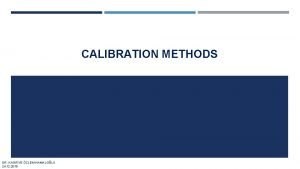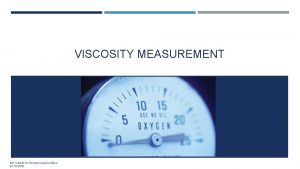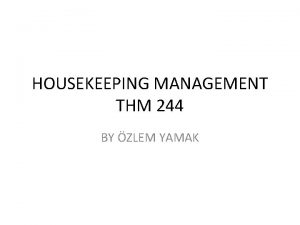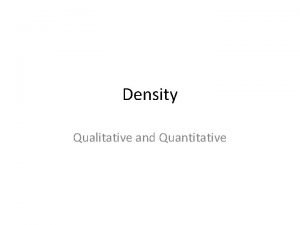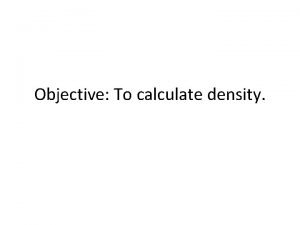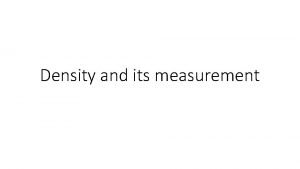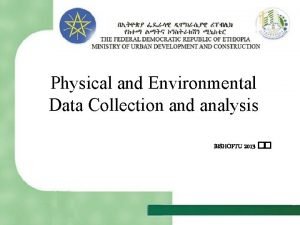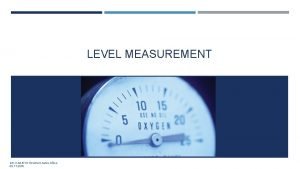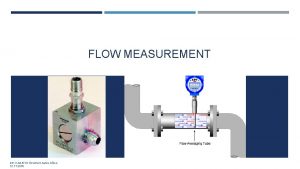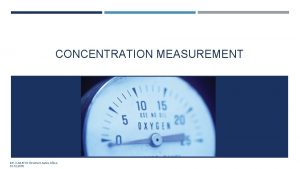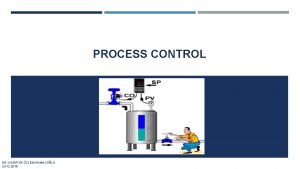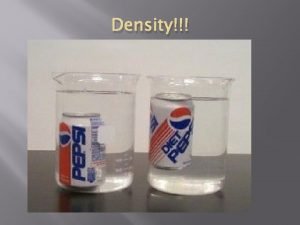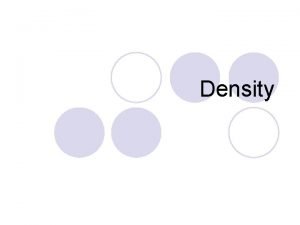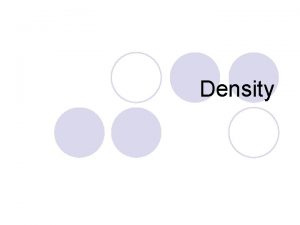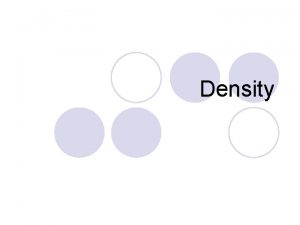DENSITY MEASUREMENT DR KADRYE ZLEM HAMALOLU 10 12


















- Slides: 18

DENSITY MEASUREMENT DR. KADRİYE ÖZLEM HAMALOĞLU 10. 12. 2018

WHAT IS DENSITY? • The density, , is elementary physical property of matter. = m / V (the ratio of its mass m to its volume V) • As it follows from equation, the SI unit of density is kg/m 3. However, g/cm 3 is another unit commonly used in a laboratory. • It is commonly used as a means of categorizing identifying different materials. • Density defined in a qualitative manner as the measure of the relative "heaviness" of objects with a constant volume. • For example: • A rock is obviously denser than a crumpled piece of paper of the same size. • A styrofoam cup is less dense than a ceramic cup. • Density may also refer to how closely "packed" or "crowded" the material appears to be again refer to the styrofoam vs. ceramic cup. DR. KADRİYE ÖZLEM HAMALOĞLU 10. 12. 2018

DENSITY The volume of an object increases with increasing temperature, because of the matter’s volumetric thermal expansion. Therefore, according to equation, the density of an object depends on its temperature, with higher temperature resulting in lower density. Exception is water in temperature range 0 -4 °C, for which the density increases with increasing temperature. DR. KADRİYE ÖZLEM HAMALOĞLU 10. 12. 2018

DENSITY Relative density, or specific gravity, is the ratio of the density (mass of a unit volume) of a substance to the density of a given reference material. Specific gravity usually means relative density with respect to water. The ratio of the density of a substance to the density of water. Relative density = s / H 2 O Specific gravity is commonly used in industry as a simple means of obtaining information about the concentration of solutions of various materials such as brines, sugar solutions (syrups, juices, honeys etc. ) and acids. DR. KADRİYE ÖZLEM HAMALOĞLU 10. 12. 2018

DENSITY OF A GAS The density of a gas further depends on the pressure as well. The relative density of gases is often measured with respect to dry air at a temperature of 20 °C and a pressure of 101. 325 k. Pa absolute. The density of an gas depends on the pressure , with higher pressure resulting in higher density. Nevertheless, this effect is negligible in a case of liquid and/or solid matter. DR. KADRİYE ÖZLEM HAMALOĞLU 10. 12. 2018

DENSITY DETERMINATION OF LIQUIDS There are several experimental methods used for density determination of liquids. 1 - Pycnometer -Density determination of liquids by pycnometer -Density determination of solid matter by pycnometer 2 - Westphal Balance DR. KADRİYE ÖZLEM HAMALOĞLU 10. 12. 2018

PYCNOMETER The pycnometer is - a glass flask with - a close-fitting ground glass stopper with - a capillary hole through it, so that air bubbles may escape from the apparatus. This fine hole releases a spare liquid after closing a top-filled pycnometer and allows for obtaining a given volume of measured and/or working liquid with a high accuracy. DR. KADRİYE ÖZLEM HAMALOĞLU 10. 12. 2018

PYCNOMETER • Density determination by pycnometer is a very precise method. • A pycnometer is in principal just a vessel of a particular fixed internal volume V. • It uses a working liquid with wellknown density, such as water. • If you first fill it with a liquid of unknown density weighs it and if you do the same with water you can determine the density of the liquid. DR. KADRİYE ÖZLEM HAMALOĞLU 10. 12. 2018

PYCNOMETER First we fill pycnometer with distilled water. The volume of water that is filling the pycnometer and the stopper is where m. H 2 O is experimentally determined weight of water (empty pycnometer weight subtracted). We repeat the procedure for the liquid with unknown density L and determine its weight m. L (measured weight minus weight of empty pycnometer). Volume V obtained in this measurement is the same as the volume of water determined from equation. DR. KADRİYE ÖZLEM HAMALOĞLU 10. 12. 2018

PYCNOMETER It follows alternated equation Combining equations yields a relation that provides the density of measured liquid DR. KADRİYE ÖZLEM HAMALOĞLU 10. 12. 2018

DENSITY DETERMINATION OF SOLID MATTER BY PYCNOMETER Pycnometer can be also used to determine the density of the solid phase in porous solids. To determine the density of a porous solid, a sample must first be crushed, ground, or powdered to the point that all pores are opened. Pycnometers can then be used. The density of homogeneous solid object does not dissolve in working liquid or immersion liquid (for example; water, ethanol). The powder is added to the pycnometer, which is then weighed, giving the weight of the powder sample. The pycnometer is then filled with a liquid of known density, in which the powder is completely insoluble (immersion liquid). The weight of the displaced liquid can then be determined, and hence the specific gravity of the powder. DR. KADRİYE ÖZLEM HAMALOĞLU 10. 12. 2018

DENSITY DETERMINATION OF SOLID MATTER BY PYCNOMETER First, we need to measure the weight of pycnometer together with inserted object m 0+m. S (m 0 = mass of empty pycnometer; m S = mass of unknown solid). We add water and determine the weight m H 2 O (measured weight minus m 0+m. S). The volume of added water V H 2 O can be obtained as The volume of measured solid object VS is the difference between the volume of water that fills the empty pycnometer V and volume V H 2 O Density of measured object S can be then calculated as DR. KADRİYE ÖZLEM HAMALOĞLU 10. 12. 2018

DENSITY DETERMINATION OF SOLID MATTER BY PYCNOMETER mp mass of empty pycnometer (with stopper) mp + m imm. lq mass of immersion liquid filled pycnometer mp + m S mass of solid filled pycnometer mp + m imm. lq+ m. S mass of immersion liquid and solid filled pycnometer imm. lq density of immersion liquid S Unknown density of solid (mp + ms) - mp s = --------------------------- x imm. lq DR. KADRİYE ÖZLEM HAMALOĞLU 10. 12. 2018 [(mp + mimm. lq)- mp]-[(mp + mimm. lq+m. S)- (mp + m. S)]

EXAMPLE A student collected the following data in attempting to determine the density of an unknown solid by the pycnometer method which used immersion liquid as Et. OH ( = 0. 802 g/cm 3). Determine the density of the unknown solid. mp = 10. 8542 g mp + m. S = 11. 0402 g mp + m imm. lq = 18. 8746 g mp + m imm. lq+ m. S= 18. 9551 g DR. KADRİYE ÖZLEM HAMALOĞLU 10. 12. 2018

WESTPHAL BALANCE Westphal Balance is an older type of specific gravity balance. This Westphal Balance is shown in its box, along with the characteristic Ushaped balancing masses and the plummet in the upper right-hand corner. The sliding top of the box has the decorative molding attached to it. DR. KADRİYE ÖZLEM HAMALOĞLU 10. 12. 2018

WESTPHAL BALANCE DR. KADRİYE ÖZLEM HAMALOĞLU 10. 12. 2018 • For extremely accurate density readings one may prefer to use a pycnometer although for speed and ease of use a Westphal can quickly provide a very close approximation to the true density of any liquid solution. • The Westphal Balance operates by suspending a glass tube (with a mercury thermometer contained within it)into a sample of a solution of unknown density via a thin platinum wire. • The scale is balanced by an array of horseshoe shaped counterweights which come in 5 g, 0. 05 g, and 0. 005 g masses.

HYDROMETERS Hydrometers are the simplest device for measuring the specific weight or density of a liquid. The device consists of a graduated glass tube, with a weight at one end, which causes the device to float in an upright position. The device sinks in a liquid until an equilibrium point between its weight and buoyancy is reached. The specific weight or density can then be read directly from the graduations on the tube. Induction hydrometers are used to convert the specific weight or density of a liquid into an electrical signal. In this case, a fixed volume of liquid set by the overflow tube is used in the type of setup. The displacement device, or hydrometer, has a soft iron or similar metal core attached. The core is positioned in a coil which forms part of a bridge circuit. As the density/specific weight of the liquid changes, the buoyant force on the displacement device changes. This movement can be measured by the coil and converted into a density reading. DR. KADRİYE ÖZLEM HAMALOĞLU 10. 12. 2018

VIBRATION SENSORS • Vibration sensors are an alternate method of measuring the density of a fluid. Fluid is passed through a U tube which has a flexible mount so that it can vibrate when driven from an outside source. • The amplitude of the vibration decreases as the specific weight or density of the fluid increases, so that by measuring the vibration amplitude the specific weight/density can be calculated. • Pressure at the base of a column of liquid of known height (h) can be measured to determine the density and specific gravity of a liquid. • The density of the liquid is given by • The specific DR. KADRİYE ÖZLEM HAMALOĞLU 10. 12. 2018 weight is given by
 Lod
Lod Kadrye
Kadrye Capillary viscometer
Capillary viscometer Area inventory list in housekeeping example
Area inventory list in housekeeping example Zlem side effects
Zlem side effects High density low density
High density low density Linear density bcc
Linear density bcc Arithmetic density
Arithmetic density High arithmetic density
High arithmetic density Linear density of atoms
Linear density of atoms Specific gravity calculation
Specific gravity calculation Density
Density Physiological density
Physiological density Density definition
Density definition Density mass volume triangle
Density mass volume triangle Population density formula
Population density formula Relationship between air pressure and density
Relationship between air pressure and density Frequency density
Frequency density Density particles
Density particles
